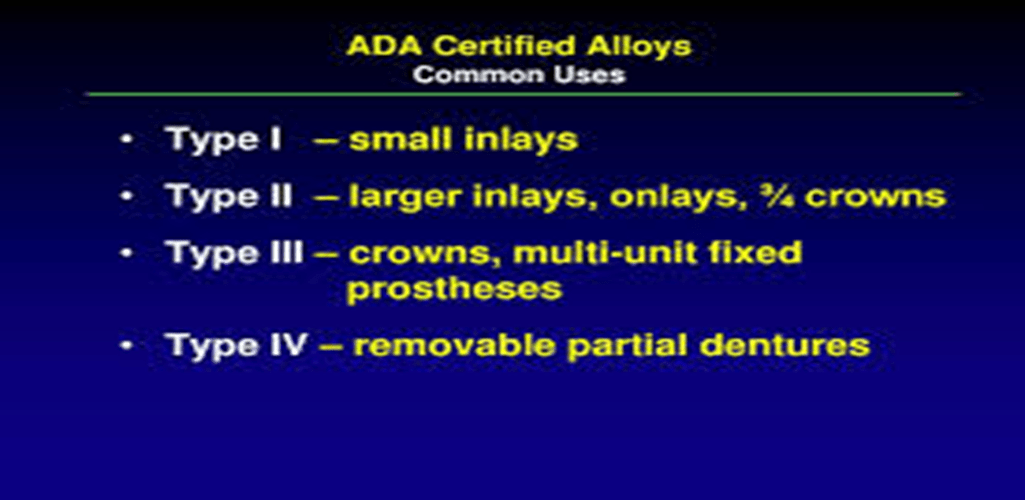What are the classifications of restorations?
1. Indirect - constructed outside the mouth
2. Direct - constructed inside the mouth
(amalgam, composite)
3. Fixed - cannot be removed from the oral cavity
(crowns, bridges)
4. Removable - can be removed by the patient from the oral cavity
(complete and partial dentures)
What are the different waxes used in Dentistry?
1. Inlay Casting Waxes- Unique because it completely burns out without residue, hard, higher melting temperature.
2. Sticky Wax -Hard wax, high melting point, sticks well
3. Base Plate Wax - Used in denture fabrication, bite registration wax.
4. Utility Waxes -Rope wax, boxing wax
What is a complete denture?
A complete denture is a removable dental prosthesis used to replace all of the natural teeth in either the upper or lower jaw, or both. It consists of artificial teeth set in a base made to resemble the natural gums, providing both functional and aesthetic benefits for people who have lost all their teeth in a particular arch.
_______ is a dental prosthesis that replaces one or more missing teeth in the upper or lower jaw. Unlike a complete denture, it is used when some natural teeth remain.
It typically consists of replacement teeth attached to a metal or plastic framework that fits securely around the remaining natural teeth, and it can be removed and reinserted by the patient for cleaning or comfort.
A. Full Denture
B. Partial Denture
C. Retainer
Answer: Partial Denture
What are the types of indirect restorations?
Indirect - use ceramic material, such as porcelain. Requires a prepared tooth surface.
1. Inlays – intra-coronal (small Class I or II cusps not included)
2. Onlays - restores one or more cusps.
3. Veneers - thin layer of porcelain or composite bonded to the facial aspects of teeth.
4. Crowns - replaces a significant amount of tooth structure.
5. Dental Bridges - replaces a missing tooth or teeth.
What are the desirable properties of an inlay wax?
-Uniform when softened
-Color contrast with the die
-No flakiness or roughening when shaping and carving
-Carvable without chipping
-Burn out completely without leaving a residue
-Rigid and stable until burned out
What are Components of a Denture?
1. Denture teeth can be -
Acrylic resin teeth or Ceramic teeth (very rarely used nowadays)
2. Pink denture base-
Fabricated in the dental laboratory on the master cast, which is a positive reproduction of the patient’s alveolar ridge.
What are the classifications of crowns based on the materials of fabrication?
1. Metal Restorations - are very tough and work well in high stress situations, esthetics are not critical.
2. Ceramic Restorations - used when esthetics are important (lacking in toughness and fracture resistance)
3. Ceramo-Metal Restorations - baking ceramic on metal (porcelain fused to metal - PFM).
4. Composite Restorations - used as fixed direct restorations. Limited success because their strength and toughness do not meet those required by crown and bridge materials.
What is a dental casting alloy?
1. Noble Alloys – a metal that is formed by a mixture of several elements rather than a pure metal.
2. Alloys used in indirect restorations (traditionally gold alloys are used).
3. Gold alloys – (gold 75%, copper 5%, Palladium 2%, Zn 1%)
*Properties of casting alloys (specification by ADA) based on their performance:
-Strength
-Elongation
-Tarnish
-Biocompatibility
-To classify as a high noble metal, at least 60% of its composition must be gold, platinum, palladium, and silver noble metals. Of that 60%, at least 40% of that percentage must be gold. For noble metals at least 25% must be noble metal and the base less than 25% noble metal.
What is acrylic resin?
In Dentistry, acrylic resins are used for temporary crowns and custom trays in addition to the bases for complete and partial dentures.
Acrylic Resins are hard, brittle, glassy polymers.
Two forms of acrylic resins are used for the fabrication of dentures:
•Chemically Activated (cold-cure)
•Heat Activated (heat-cure)
What are the factors that influence the design of the restorations?
1. Esthetic requirements posterior vs. anterior
2. Attrition rate of the restoration porcelain opposing acrylic or natural dentition
porcelain requires more tooth structure removal than metal crowns
3. Biocompatibility of the material allergies
4. Location of the margins of a restoration supra-gingival vs. sub-gingival margins
5. Occlusal evaluation para-functional habits
True or False: Non-Precious Alloys such as Nickel and Chromium can be considered a Casting Alloy.
TRUE: Non-Precious Alloys
example: Nickel (80%) chromium (10%)
-Stronger and harder than the noble ceramo-metal alloy and are much less expensive
-Most difficult to cast
-Nickel allergy
Two forms of acrylic resins are used for the fabrication of dentures:
Answer:
1. Chemically Activated (cold-cure)
2. Heat Activated (heat-cure)
What is a temporary restoration?
Temporary restorations serve the dual purpose of providing functional and aesthetic benefits while patients are waiting for a permanent dental crown to be fitted. They allow patients to speak and chew as normal after a dental procedure, and they also help to protect the sensitive area from harm while a permanent crown is being fabricated.
What are the ADA classifications of alloys based on properties and compositions?

Alloys Type I – weakest, greatest elongation (used for inlays)
Alloy Type IV - strongest, least elongation, used in high-stress bridges and partials.
List some Roles of a hygienist in relation to Prosthesis, such as dentures or partial dentures.
-Significant patient education on preventing the need for dentures.
-Home care for the oral removable prostheses
-Overuse of adhesives, is an ill-fitting denture, may need of denture reline.